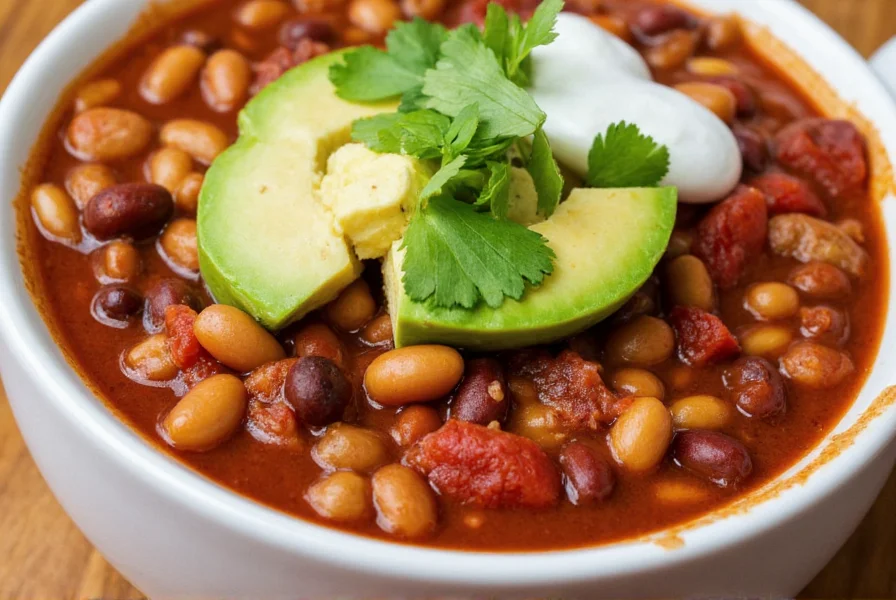Bean chili represents one of America's most beloved comfort foods with roots tracing back to Spanish colonial influences in the American Southwest. Unlike meat-based chili con carne, bean chili offers a satisfying vegetarian alternative that's packed with fiber, protein, and essential nutrients while maintaining that signature spicy warmth chili enthusiasts crave.
The Essential Components of Authentic Bean Chili
Creating exceptional bean chili requires understanding its foundational elements. The magic happens when quality ingredients combine through proper technique. Start with dried beans rather than canned for superior texture and flavor absorption, though canned beans work well for weeknight meals when rinsed thoroughly.
For the perfect vegetarian bean chili recipe, you'll need:
| Ingredient Category | Essential Components | Optional Enhancements |
|---|---|---|
| Beans | Kidney, black, or pinto beans (2-3 varieties) | Anasazi beans, navy beans |
| Base | Crushed tomatoes, tomato paste | Fire-roasted tomatoes, chipotle peppers in adobo |
| Aromatics | Onions, garlic, bell peppers | Jalapeños, poblano peppers |
| Spices | Cumin, chili powder, smoked paprika | Cinnamon, cocoa powder, oregano |
| Liquid | Vegetable broth, water | Beer, coffee |

Step-by-Step Bean Chili Preparation Guide
Follow these steps for the best homemade bean chili that develops complex flavors through proper technique:
- Prepare beans: If using dried beans, soak overnight or use quick-soak method (boil 2 minutes, then steep 1 hour). Drain and rinse.
- Sauté aromatics: Cook onions, garlic, and peppers in olive oil until softened (about 5-7 minutes).
- Bloom spices: Add cumin, chili powder, and paprika to the aromatics, stirring constantly for 1 minute to release essential oils.
- Build flavor base: Stir in tomato paste and cook 2-3 minutes until it darkens slightly.
- Add liquids and beans: Pour in crushed tomatoes and vegetable broth, then add beans.
- Simmer patiently: Cook uncovered for 30-45 minutes, stirring occasionally. For deeper flavor, simmer 2-3 hours on low heat.
- Finish and adjust: Stir in lime juice and adjust seasoning. For thicker chili, mash some beans against the pot side.
Popular Bean Chili Variations for Different Dietary Needs
Bean chili adapts beautifully to various preferences and restrictions. Understanding these different types of bean chili helps you customize for any occasion:
- Three-Bean Vegetarian Chili: Combines kidney, black, and pinto beans with corn and zucchini for added texture
- Vegan White Bean Chili: Uses cannellini beans, green chilies, and tomatillos for a lighter alternative
- Smoky Chipotle Bean Chili: Incorporates chipotle peppers in adobo for deep, complex heat
- Southwest Black Bean Chili: Features black beans, corn, and cumin with a touch of cocoa powder
- Slow Cooker Bean Chili: Perfect for hands-off preparation with 6-8 hours of gentle simmering
Nutritional Benefits of Bean Chili
Bean chili delivers impressive nutritional benefits of bean chili that make it both delicious and health-promoting. A single serving typically provides:
- 15-20 grams of plant-based protein
- 25-30% of daily fiber needs
- Significant iron, magnesium, and potassium
- Antioxidants from tomatoes and chili peppers
- Low in saturated fat while being naturally cholesterol-free
Studies show regular bean consumption correlates with improved heart health, better blood sugar control, and increased satiety—making bean chili an excellent choice for weight management and overall wellness.

Serving Suggestions and Toppings
Elevate your easy bean chili recipe with these complementary toppings that add contrasting textures and flavors:
- Fresh toppings: Diced avocado, cilantro, green onions, lime wedges
- Creamy elements: Greek yogurt, sour cream, or vegan alternatives
- Crispy additions: Tortilla strips, crushed corn chips, or fried onions
- Heat boosters: Sliced jalapeños or hot sauce for extra spice
- Traditional pairings: Cornbread, rice, or crusty bread for dipping
Storage and Reheating Best Practices
Bean chili often tastes even better the next day as flavors continue to meld. For optimal results:
- Cool completely before storing to prevent condensation
- Store in airtight containers for up to 5 days in the refrigerator
- Freeze in portion-sized containers for up to 3 months
- Reheat gently on the stove with a splash of broth to restore consistency
- Avoid microwaving large portions unevenly—stir frequently if using microwave
Common Bean Chili Mistakes to Avoid
Even experienced cooks make these common bean chili mistakes that compromise flavor and texture:
- Skipping the spice blooming step: Adding spices directly to liquid prevents flavor development
- Over-relying on canned beans: While convenient, they lack the texture control of properly cooked dried beans
- Adding acidic ingredients too early: Tomatoes and vinegar can prevent beans from softening properly
- Underseasoning: Chili needs generous seasoning—taste and adjust throughout cooking
- Rushing the simmer time: Proper flavor development requires at least 30 minutes of simmering
Frequently Asked Questions
Can I make bean chili without tomatoes?
Yes, you can create tomato-free bean chili using alternatives like roasted red peppers, tomatillos for verde chili, or even butternut squash puree for a sweet contrast to the spices. Simply replace the tomato component with an equal amount of your chosen substitute and adjust spices accordingly.
How do I thicken bean chili that's too watery?
To thicken watery bean chili, try these effective methods: simmer uncovered to reduce liquid, mash some beans against the pot side to release starch, create a cornstarch slurry (1 tablespoon cornstarch mixed with 2 tablespoons cold water), or add a small amount of masa harina. Each technique thickens without altering flavor significantly.
What's the difference between chili beans and regular beans?
Chili beans typically refer to beans that have been cooked with chili seasonings, while regular beans are plain. Canned chili beans contain pre-seasoned beans in a tomato-chili sauce, whereas regular canned beans require seasoning during cooking. For authentic bean chili, starting with plain beans gives you complete control over flavor development.
How can I make bean chili less spicy?
To reduce spiciness in bean chili, add acidic elements like lime juice or vinegar, incorporate dairy (sour cream or yogurt), stir in a small amount of sugar or honey, or increase non-spicy components like additional beans or tomatoes. Remember that chili's heat intensifies as it sits, so adjust seasoning after complete cooling.
Can bean chili be frozen successfully?
Yes, bean chili freezes exceptionally well due to its high bean and tomato content. Cool completely, then store in airtight containers or freezer bags with 1-inch headspace for expansion. Properly frozen bean chili maintains quality for 3-4 months. Thaw overnight in the refrigerator before reheating gently on the stove.











 浙公网安备
33010002000092号
浙公网安备
33010002000092号 浙B2-20120091-4
浙B2-20120091-4